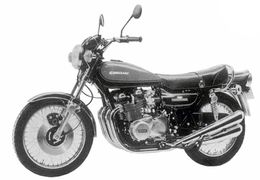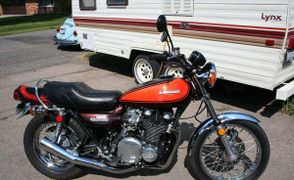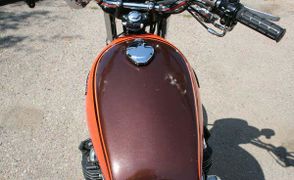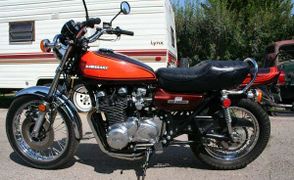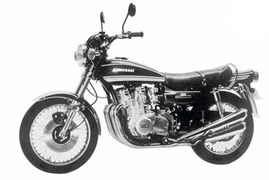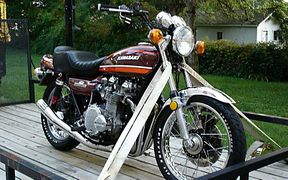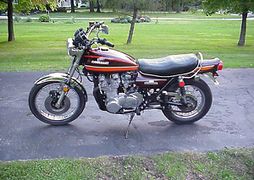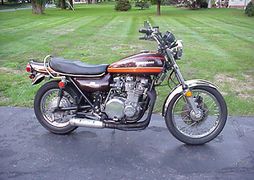Kawasaki Z1: review, history, specs
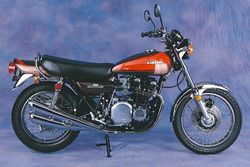 |
|
| Kawasaki Z1 | |
| Manufacturer | [[Kawasaki]] |
|---|---|
| Also called | Z1, Z900, KZ900, Z1A, Z1B |
| Production | 1973 - 1975 |
| Class | [[:Category:Superbike motorcycles|Superbike]] [[Category:Superbike motorcycles]] |
| Successor | Kawasaki KZ900A |
| Engine | |
| Bore / Stroke | 66 x 66mm |
| Compression ratio | 8.5:1 |
| Top Speed | 130mph |
| Horsepower | 81.94 HP (61.1 KW) @ 8500RPM |
| Torque | 53.84 ft/lbs (73.0 Nm) @ 7000RPM |
| Fuel System | 4x Mikuni VM 28mm carburetors |
| Spark Plug | NGK B8ES 73-75 |
| Battery | YUASA 12N14-3A 73-75 |
| Transmission | 5-Speed Return Shift |
| Frame | tubular steel, double cradle |
| Suspension | Front: telescopic forks Rear: swingarm / twin shocks |
| Front Tire | 3.25-19 73-75 |
| Rear Tire | 4.00-18 73-75 |
| Weight | |
| Oil Filter | K&N KN-401 |
| Fuel Consumption | 45 mpg (average) |
| Related | Kawasaki KZ900A Kawasaki KZ1000A |
| Competition | Honda CB750K Triumph Trident Suzuki GT750 |
| Manuals | Service Manual |
|
Reviews · |
|
The Kawasaki Z1 was a Air cooled, four stroke, transverse four cylinder, DOHC, 2 valves per cylinder superbike motorcycle produced by Kawasaki from 1973 to 1975. Max torque was 53.84 ft/lbs (73.0 Nm) @ 7000 RPM. Claimed horsepower was 81.94 HP (61.1 KW) @ 8500 RPM.
Intro
Kawasaki's earlier two and three-cylinder bikes such as the H1, and H2 had bestowed Kawasaki with a high performance image. But these bikes had known problems: excessive fuel consumption, noise, vibration, and less than perfect handling. Their sparse comfort relegated them to the role of street racer. Kawasaki engineers had outlined these limitations of their two-stroke triples as early as 1967. This led to the beginning stages of planning a four-stroke super cruiser in the mold of the 1000cc Vincent, that could be ridden in any situation, and would be "THE" bike all experienced riders lusted after.
New York Steak
The Kawasaki Z1 gave the world its first true superbike. Introduced in late 1972, the Z1 was Kawasaki's first four-cylinder, four-stroke motorcycle. During its planning stages it was called the codenamed the T-103 and nicknamed the 'New York Steak'. Before the introduction of the Honda CB750K to the world at the October 1968 Toko Motor Show, Kawasaki had already sent a mock-up double overhead camshaft Z1 to US Kawasaki's Sam Tanegashima. Honda's head start caused Kawasaki to be patient and carefully judge the revolutionary bike's impact.
Reception
The Z1 became the "King of the Road" and an industry leader; as the first production motorcycle to bring such high performance and prestige to the general public. Cycle Magazine recorded a standing quarter mile time of 12.83 seconds @ 101.7 mph.
Impact on the industry
All other manufacturers had to change their mindset to keep up with popularity of this motorcycle. By the end of the decade all Japanese manufacturers had developed machines to rival the Z1 which were almost direct clones of its engine configuration and integral body panels.
These bike wars directly lead to the demise of the flagging BrItish motorcycle industry.The American motorcycle industry (mainly Harley-Davidson) was also on its last legs and was only saved by radical restructuring and inventive financing.
Design changes
The basic design of the Z1 remained relatively unchanged until the early 1980s with the exception of increased engine displacement (1015cc). This model is also the basis for the motorcycle used by most police forces across the United States to this day.
Discontinuation
Only recently (2005) did Kawasaki announce that it would discontinue production of the police model, 25 years after the production on the consumer model and 32 years after its introduction.
Engine
A 63.5mm bore x 63.5mm stroke result in a displacement of just 903.0 cubic centimeters.
Drive
The bike has a 5 Speed transmission.
Chassis
It came with a 3.25-19 front tire and a 4.00-18 rear tire. Stopping was achieved via Single disc in the front and a Drum in the rear. The front suspension was a Telescopic forks while the rear was equipped with a Dual shocks.
1973 Z1
- Color
- Fuel Tank: Candy Yellow/Green, Candy Orange/Brown (UK & Europe); Candy Orange/Brown (US)
- Front Fender: Chrome
- Engine No.: Z1E000001-
- Frame No.: Z1F-000001-
- Parts Catalog No.: 99997-603, (E) 99997-608S
- Owner's Manual No. : 99997-800
- Shop Manual No. : 99997-700
The First Z1.
1974 Z1A
- Color
- Fuel Tank: Candy Tone Brown/Orange, Candy Tone Yellow/Green
- Front Fender: Chrome
- Engine No.: Z1E020001-
- Frame No.: Z1F-020001-
- Parts Catalog No. : 99997-627, (E) 99997-627-01S
- Owner's Manual No. : 99997-808, (E) 99997-021, (F) 99983-009, (I) 99983-010, (W) 99983-011
- Shop Manual No.: 99997-700
Major changes for this model were the silver engine finish, redesigned tank and tailpiece markings and a stop lamp failure light in the tachometer. The idiot light cover was also changed, the warning lights were now placed in a different order. In mid 1974 there was a slight carburetor change to improve cold running. At the end of 1974 Kawasaki had produced over 80,000 units of the Z1 and Z2. The best gets better.
1975 Z1B
- Color
- Fuel Tank: Candy Super Blue, Candy Super Red
- Front Fender: Chrome
- Engine No.: Z1E047500-
- Frame No.: Z1F-047500-
- Parts Catalog No.: 99997-627-50S, (E) 99997-627-51S
- Owner's Manual No.: 99997-832
- Shop Manual No.: 99997-700
- Major Changes: Color and marking. Special chain provided with sealed-in grease. Automatic chain oiler discontinued.
Kawasaki dropped the automatic chain oiler in favor of an o-ring chain. The front forks received revised dampers and softer springs. To improve low speed running there was a new automatic ignition advance. Unlike on the trend with the H1 these changes didn't drop performance.
1976 Z1
The model designation was changed to KZ900A and started in 1976 with the KZ900-A4 model.
In Media
External Links
| ||||||||||||||
